The drain pump in the washing machine does not work
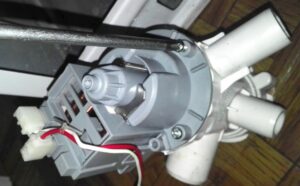 You can suspect that the pump in the washing machine is not working based on several obvious “symptoms”. Sometimes the problem is limited to wet things in the drum, and sometimes the machine suddenly stops with a full tank of water. In any case, the quality of washing suffers, and the equipment threatens to completely fail. Often the pump that needs to be repaired or replaced is to blame for difficult drainage, but first, we diagnose the drainage and clarify the cause of the failure.
You can suspect that the pump in the washing machine is not working based on several obvious “symptoms”. Sometimes the problem is limited to wet things in the drum, and sometimes the machine suddenly stops with a full tank of water. In any case, the quality of washing suffers, and the equipment threatens to completely fail. Often the pump that needs to be repaired or replaced is to blame for difficult drainage, but first, we diagnose the drainage and clarify the cause of the failure.
How does a pump malfunction manifest itself?
The machine stops draining for many reasons, and pump failure is only one of them. It is irrational to immediately “blame” the pump and start repairing it; it is better to conduct a comprehensive diagnosis of the drainage and exclude third-party problems. First of all, we note the existing “symptoms”. The following signs indicate problems with drainage:
- the corresponding error code is displayed (the machine’s self-diagnosis system displays a code, after decoding which it will become clear who is to blame, the pump or other drainage element);
- The machine washes in the standard mode, but stops before spinning;
- the pump does not turn on at all, the machine does not hum;
- the pump works non-stop, constantly humming;
- water is drained at a slow pace (instead of 2-3 minutes - 10-15 minutes);
- The machine drains intermittently, every other time.

Diagnostics is complicated by similar “symptoms” - breakdown or blockage of each drainage element manifests itself in the same way. To determine the cause of the failure, you will have to sequentially check the drain system, moving from simple to complex. The procedure is as follows:
- look at the dashboard and make sure that the “spin” mode has been turned on (some programs, delicate, wool or manual, do not include spinning);
- check the set number of revolutions (perhaps the drain mode was disabled by mistake);
- try to “reset” the error: turn on the spin cycle and start the cycle;
- assess the condition of the drain hose (the hose should be located below the level of the tank and not be pinched or bent);
- probe the corrugation to ensure it is not clogged;
- disconnect the drainage hose from the sewer, turn on the drain and lower the free end of the corrugation into a basin or toilet (it is possible that the problem is in the common riser).
The next step is to check the garbage filter. Open the technical hatch door, unscrew the nozzle and clean it of debris and scale. We immediately inspect the seat of the “trash bin”, and also use a flashlight to shine a light through the pump and impeller. The blades of the latter are often blocked by wound hair or threads.
Without assembling the machine, we start the spin cycle, return to the drain system and evaluate the performance of the impeller. If the blades remain motionless after starting the cycle, it means the pump is broken. In this case, it is necessary to dismantle the pump and “ring”.
Is the pump difficult to access?
To check the pump for serviceability, you need to find it. You can see the pump through the garbage filter, but you can’t touch it and carefully examine it. To do this you will have to get closer to her. Instructions on what to do depend on the manufacturer of the washing machine. On slot machines from Samsung Candy, Ariston, Indesit, Beko, Whirlpool and LG you can get to the pump through the bottom. The algorithm is as follows:
- disconnect the washing machine from communications;
- drain the water by unscrewing the garbage filter;
- pull out the powder receptacle and drain the water from it;
- lay a blanket or carpet next to the machine;
- Place the washer on its side.
Before repairing, the washing machine must be de-energized and disconnected from communications!
On Zanussi and Electrolux cars, access to the pump is through the rear panel. Disconnected from the network and water supply, the washing machine unfolds and is freed from the “back”. All that remains is to find the pump - under the washing tub.
It is more difficult for users of Bosch, Siemens and AEG - here the pump is hidden by the front wall. You will have to partially disassemble the machine body: remove the top cover, powder receptacle and instrument panel, insert the cuff into the drum and turn off the UBL. Then the end is removed and access to the pump is freed.
Leakage at the pump housing or volute
If during diagnostics it turns out that the machine is leaking from below, then the pump is faulty. You need to get to the pump and start repairs. First of all, the drain pipe is inspected for damage, reliability of fixation and blockages. Sometimes it is enough to clean the hose, but more often a replacement is required. Next we proceed like this:
- disconnect the wiring connected to the pump;
- loosen the fasteners;
- take the pump out of the machine;
- We inspect the impeller.
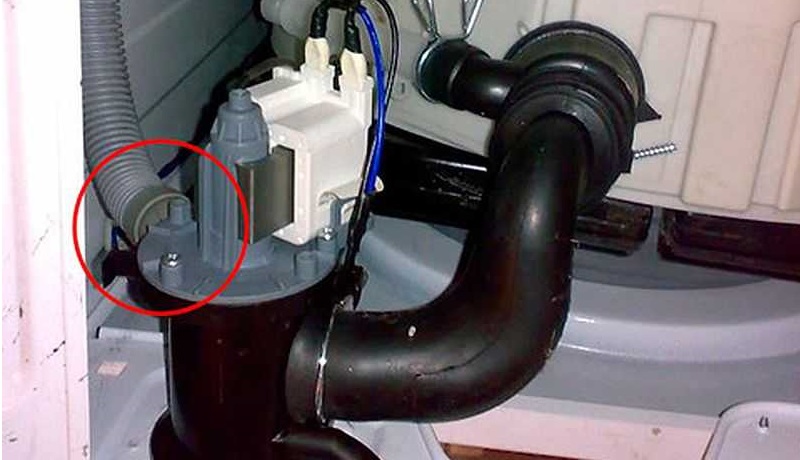
Most pumps are dismountable: the cover can be removed by unscrewing the retaining bolts. Afterwards the snail is removed, and the device itself is checked for leaks. Be sure to test the pump with a multimeter in ohmmeter mode.
The pump pumps all the time
It’s another matter if the pump constantly works or does not turn on at all. In this case, the control board is often to blame, which does not give the pump a command to turn off or start. As a result, the machine is “silent” or endlessly pumps out water. Checking and changing the module yourself is risky - it’s better to contact a service center.
The pump does not stop or does not start at all even if the pressure switch breaks down. A faulty level sensor incorrectly transmits information to the module, underestimating or overestimating the readings. As a result, the pump either “does not know” that the tank is full or runs idle. You can check the pressure switch yourself. It is enough to remove the top cover, find the device, disconnect the tube, inspect it and clean it. If there is obvious damage, we replace it.
Extend the life of your pump
Replacing a burnt-out pump is easy, but it’s even easier and cheaper to prevent it from breaking. The pump rarely breaks, especially if you use the machine correctly. We are talking about the following recommendations:
- observe the loading rate (if overloaded, the washing machine wears out, including the pump);
- check pockets before washing (forgotten garbage ends up in the drain and clogs it);
- Clean the washing machine regularly (every 1-4 months);
- organize a filtration system (hard and dirty water shortens the life of the machine).
You can clean or replace the pump yourself. The main thing is to make sure that it is faulty and not to deviate from the instructions.
Interesting:
Reader comments
- Share your opinion - leave a comment
Categories
Washing machine repair


For buyers

For users

Dishwasher

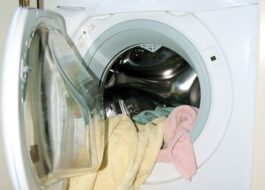
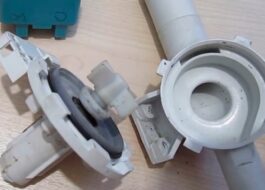


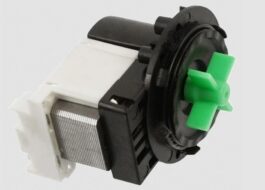











Add a comment